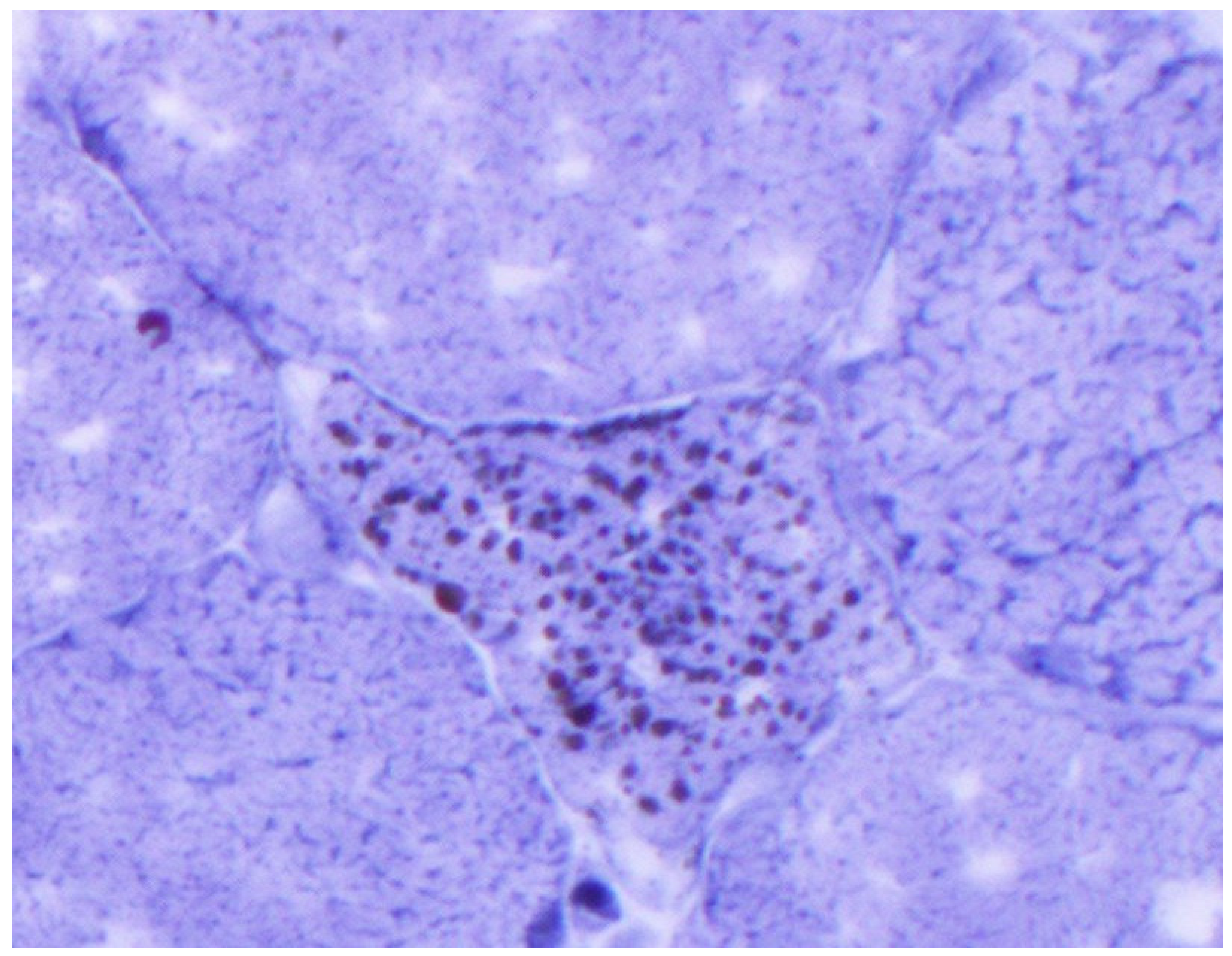An Ounce of Prevention, a Pound of Complications: A Case of Statin-Induced Necrotizing Myopathy in a Frail Elderly Patient
Abstract
1. Introduction
2. Case Report
3. Discussion
Author Contributions
Funding
Institutional Review Board Statement
Informed Consent Statement
Data Availability Statement
Conflicts of Interest
References
- Saeed, A.; Mehta, L. Statin therapy in Older Adults for Primary Prevention of Atherosclerotic Cardiovascular Disease: The Balancing Act. American College of Cardiology. 20 October 2020. Available online: https://www.acc.org/latest-in-cardiology/articles/2020/10/01/11/39/statin-therapy-in-older-adults-for-primary-prevention-of-atherosclerotic-cv-disease (accessed on 27 December 2020).
- US Preventive Services Task Force. Statin Use for the Primary Prevention of Cardiovascular Disease in Adults: U.S. Preventive Services Task Force Recommendation Statement. JAMA 2016, 316, 1997–2007. [Google Scholar]
- Curfman, G. Risks of Statin Therapy in Older Adults. JAMA Intern. Med. 2017, 177, 966. [Google Scholar] [CrossRef][Green Version]
- Caylor, T.L.; Perkins, A. Recognition and management of polymyalgia rheumatica and giant cell arteritis. Am. Fam. Physician 2013, 88, 676–684. [Google Scholar] [PubMed]
- Salvarani, C.; Cantini, F.; Boiard, F.; Hunder, G.G. Polymyalgia rheumatica and giant-cell arteritis. N. Engl. J. Med. 2002, 347, 261–271. [Google Scholar] [CrossRef] [PubMed]
- Mammen, A. Statin-Associated Autoimmune Myopathy. N. Engl. J. Med. 2016, 374, 664–669. [Google Scholar] [CrossRef] [PubMed]
- Fulcher, J.; Mihaylova, B.; O’Connell, R.; Armitage, J.; Baigent, C.; Barnes, E.; Betteridge, J.D.; Blackwell, L.; Blazing, M.; Bowman, L.; et al. Cholesterol Treatment Trialists’ Coalition. Efficacy and safety of statin therapy in older people: A meta-analysis of individual participant data from 28 randomised controlled trials. Lancet 2019, 393, 407–415. [Google Scholar]
- Orkaby, A.R.; Driver, J.A.; Ho, Y.L.; Lu, B.; Costa, L.; Honerlaw, J.; Galloway, A.; Vassy, J.L.; Forman, D.E.; Gaziano, J.M.; et al. Association of Satin Use with All-Cause Mortality in US Veterans 75 Years and Older. JAMA 2020, 324, 68–78. [Google Scholar] [CrossRef]
- Ramos, R.; Comas-Cufí, M.; Martí-Lluch, R.; Balló, E.; Ponjoan, A.; Alves-Cabratosa, L.; Blanch, J.; Marrugat, J.; Elosua, R.; Grau, M.; et al. Statins for primary prevention of cardiovascular events and mortality in old and very old adults with and without type 2 diabetes: Retrospective cohort study. BMJ 2018, 362, k3359. [Google Scholar] [CrossRef] [PubMed]
- Han, B.H.; Sutin, D.; Williamson, J.D.; Barry, D.R.; Piller, L.B.; Pervin, H.; Pressel, S.L.; Blaum, C.S. Effect of Statin Treatment vs Usual Care on Primary Cardiovascular Prevention Among Older Adults: The ALLHAT-LLT. Randomized Clinical Trial. JAMA Intern. Med. 2017, 177, 955–965. Available online: https://clinicaltrials.gov/ct2/show/NCT02099123 (accessed on 24 February 2021). [CrossRef]
- Hawley, C.E.; Roefaro, J.; Forman, D.E.; Orkaby, A.R. Statins for Primary Prevention in Those Aged 70 Years and Older: A Critical Review of Recent Cholesterol Guidelines. Drugs Aging 2019, 36, 687–699. [Google Scholar] [CrossRef]
- Mortensen, M.; Falk, E. Primary Prevention with Statins in the Elderly. J Am. Coll. Cardiol. 2018, 71, 85–94. [Google Scholar] [CrossRef] [PubMed]
- Grundy, S.M.; Stone, N.J.; Bailey, A.L.; Beam, C.; Birtcher, K.K.; Blumenthal, R.S.; Braun, L.T.; de Ferranti, S.; Faiella-Tommasino, J.; Forman, D.E.; et al. 2018 AHA/ACC/AACVPR/AAPA/ABC/ACPM/ADA/AGS/APhA/ASPC/NLA/PCNA guideline on the management of blood cholesterol: A report of the American College of Cardiology/American Heart Association Task Force on Clinical Practice Guidelines. Circulation 2019, 139, e1082–e1143. [Google Scholar] [PubMed]
- Schech, S.; Graham, D.; Staffa, J.; Andrade, S.E.; La Grenade, L.; Burgess, M.; Blough, D.; Stergachis, A.; Chan, K.A.; Platt, R.; et al. Risk factors for statin-associated rhabdomyolysis. Pharmacoepidemiol. Drug Saf. 2007, 16, 352–358. [Google Scholar] [CrossRef] [PubMed]
- Kellick, K.; Bottorff, M.; Toth, P. A Clinician’s Guide to Statin Drug-Drug Interactions. J. Clin. Lipidol. 2014, 8, S30–S46. [Google Scholar] [CrossRef] [PubMed]




| Lab | Admission | Discharge | 2 Months Post Discharge | 8 Months Post Discharge |
|---|---|---|---|---|
| CK (U/L) | 7628 | 1394 | 252 | 63 |
| AST (U/L) | 253 | 125 | 48 | 14 |
| ALT (U/L) | 319 | 162 | 59 | 8 |
Publisher’s Note: MDPI stays neutral with regard to jurisdictional claims in published maps and institutional affiliations. |
© 2022 by the authors. Licensee MDPI, Basel, Switzerland. This article is an open access article distributed under the terms and conditions of the Creative Commons Attribution (CC BY) license (https://creativecommons.org/licenses/by/4.0/).
Share and Cite
Stens, O.; Neutel, B.; Goodman, E.L. An Ounce of Prevention, a Pound of Complications: A Case of Statin-Induced Necrotizing Myopathy in a Frail Elderly Patient. Geriatrics 2022, 7, 33. https://doi.org/10.3390/geriatrics7020033
Stens O, Neutel B, Goodman EL. An Ounce of Prevention, a Pound of Complications: A Case of Statin-Induced Necrotizing Myopathy in a Frail Elderly Patient. Geriatrics. 2022; 7(2):33. https://doi.org/10.3390/geriatrics7020033
Chicago/Turabian StyleStens, Oleg, Bradley Neutel, and Elizabeth L. Goodman. 2022. "An Ounce of Prevention, a Pound of Complications: A Case of Statin-Induced Necrotizing Myopathy in a Frail Elderly Patient" Geriatrics 7, no. 2: 33. https://doi.org/10.3390/geriatrics7020033
APA StyleStens, O., Neutel, B., & Goodman, E. L. (2022). An Ounce of Prevention, a Pound of Complications: A Case of Statin-Induced Necrotizing Myopathy in a Frail Elderly Patient. Geriatrics, 7(2), 33. https://doi.org/10.3390/geriatrics7020033






